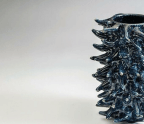The Visibility of Ceramics in Nigeria: A Review
In various cultures across the world, the ubiquity of ceramics from excavation sites is a testament to its popularity as an art form. Ogundele1, Ali2, Garcia and Haruna3 and several other researchers suggest that “pottery, the most dominant of terracotta wares, is one of the oldest crafts produced by man, from prehistoric times to the present, and the most widespread of all human activities.”4 For centuries, ceramics in its various forms, such as potshards, whole earthen wares, and complex ritual pots, were brought to light by archaeologists through excavations. These works are found preserved and displayed in various museums across the world where they have assumed a new life of historical and heritage significance.
The most notable of these ceramic works come from civilizations such as those of ancient Egypt, Greece, and Rome.5 Discovered at the bottom of the sea, ancient ruins and other sites, pottery relics have been found in significant numbers. Because of the scope of the above-mentioned civilizations, in terms of artistic achievements, the visibility of their pottery appears to overshadow those of many other cultures. Yet, less prominent civilizations had equally vibrant artistic cultures that yielded impressive pottery and contributed to the rich history of ceramics and its visibility. A cursory observation of the places where some archaeological evidence were found in Africa reveals the preponderance of terracotta (unglazed) earthen-wares, the same as those from ancient pottery cultures. Terracotta survives under adverse conditions and is immune to drawbacks such as weather, termites and rust associated with wood and iron, respectively. Consequently, Ogundele points out that it “makes up the majority of the artifactural data recovered in the archaeological records, especially in Africa where there is acute problem of preservation of materials, particularly organic artifacts.”6 As a result of this clear longevity advantage of terracotta, Fatunsin says that “from it, a historical record can be derived not only from the potsherds that litter archaeological sites, but from the continuing practice of the craft, associated as it is with traditional beliefs, festivals and other activities”7 By this, therefore, pottery becomes a fabric of history that connects our past to our present, thereby making pottery forms continuously visible in the conversations of history and antiquity.
Writing about the The pottery carries with them the various imprints of their culture, such as mythical figures, cultural performances, and other iconographies on the surfaces of the wares. These have increased their contents as purveyors of cultural norms and values. Before the introduction of foreign-made ceramics into many African societies, pottery was a primary industry that provided communities with pots, bowls, and containers. This can be ascertained from the abundance of shards found at archaeological sites. Among traditional African societies, ritual pots were used as objects of worship, containment of herbs, or as medicine bowls. These usages centralize pottery to domesticity and everyday functions. Ekong cites the example of the production of variety of pottery ranging from the smallest “Usan Ibok” (sacrificial crucible) to the bigger “Abang Itie” (sitting storage pot) and the giant pots for storing wine during festivals.”
You’re reading a preview, subscribe to read more.
Start your free 30 days





